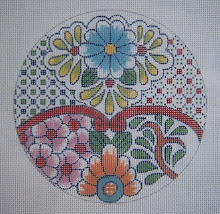 This is now beginning to be quite entertaining, as it's beginning to actually look like tartan. At this point I always want to stitch a little bit farther for a few more minutes to see what will happen next. As the weft threads travel horizontally across the vertical bands of stitcihing, it takes on a new life.
This is now beginning to be quite entertaining, as it's beginning to actually look like tartan. At this point I always want to stitch a little bit farther for a few more minutes to see what will happen next. As the weft threads travel horizontally across the vertical bands of stitcihing, it takes on a new life. I've never had any desire to paint plaid onto canvas, as it's impossible to do a true one that way, unless it's a very simple thing with very very few colors (such as gingham checks) - everywhere two colors cross each other, a new color is created. I would say "theoretically," as a needlepoint plaid is on coarse fabric - the mono canvas.
 In this example, it's 18 stitches to the inch, so where two colors cross, it shows little dots, which are easily discernible, but nevertheless interesting. A pattern that resembles a plaid can be painted - but not a true, woven one. I suppose it could be done, but what a lot of time and trouble!!!
In this example, it's 18 stitches to the inch, so where two colors cross, it shows little dots, which are easily discernible, but nevertheless interesting. A pattern that resembles a plaid can be painted - but not a true, woven one. I suppose it could be done, but what a lot of time and trouble!!!If you look at this example, you can see where the green crosses the yellow, a "yellow green" would be formed. Where green crosses white, a lighter green shows. On a woven fabric plaid with warp and weft, the thread count is normally so high that it does register visually as another color.
 This is the principle upon which the Impressionist painter Georges Seurat based his Pointillism paintings - as the eye automatically assimilates the areas of tiny dots of pure color into the color the artist intended. My goodness, that must have been slow. La Grande Jatte is enormous!! (his most famous work)
This is the principle upon which the Impressionist painter Georges Seurat based his Pointillism paintings - as the eye automatically assimilates the areas of tiny dots of pure color into the color the artist intended. My goodness, that must have been slow. La Grande Jatte is enormous!! (his most famous work) Now that this "Millenium Ribbon" tartan is taking shape, I'm wanting to work on it more, and start setting up yet another of the ribbons. I could make these narrower by decreasing the counts - as beginning with the tiniest elements - the lines. Those could be reduced to one thread only, but would not have nearly the impact they do as two lines. On this pattern, they would show up, as the white, yellow, and green are light and bright agains the blue. This is a consideration! Back to the drawing board for a while.

1 comment:
This is really coming alive and looking convincing now, and I'm beginning to get the idea of the technique you're using - great work!
Post a Comment